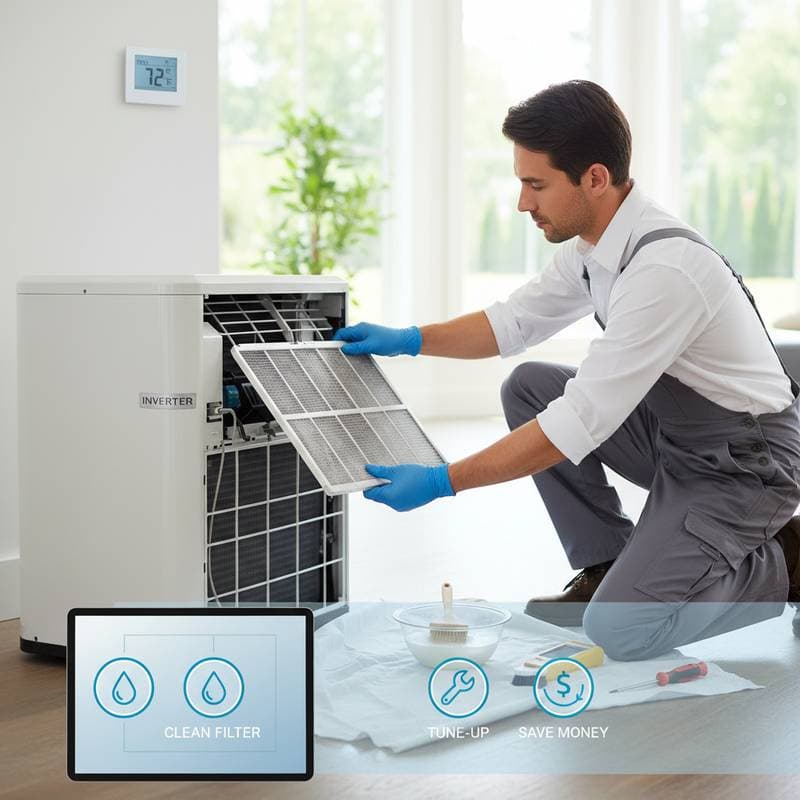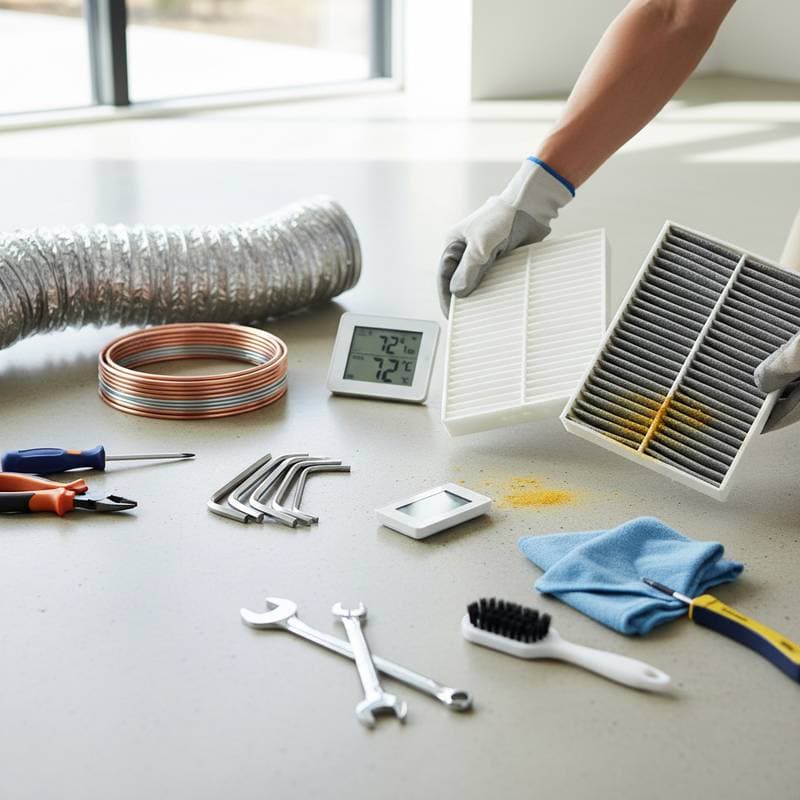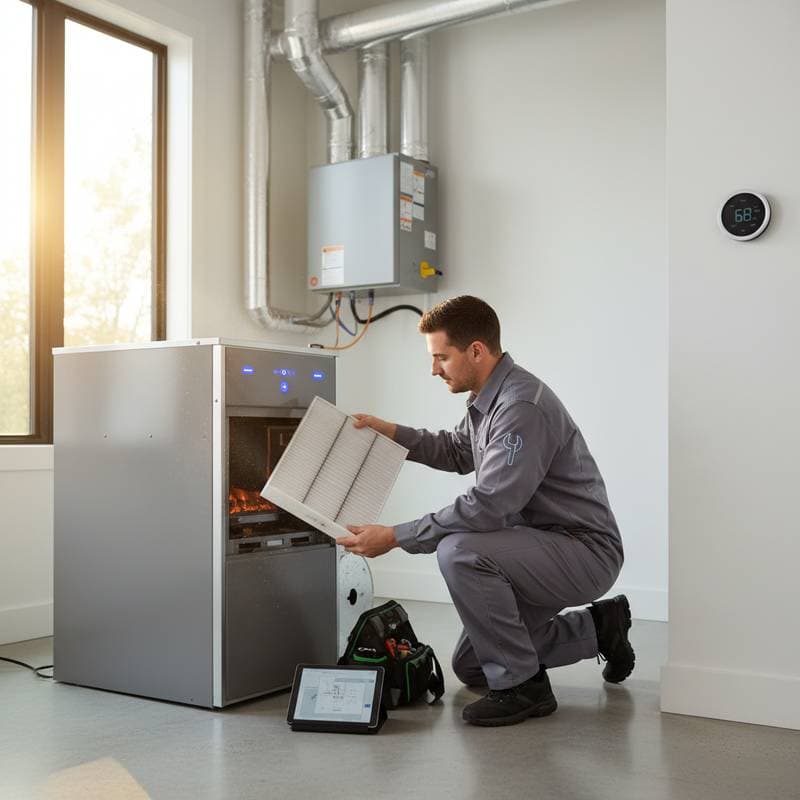Essential AC Preparation to Avoid Summer Failures
A functional air conditioner represents more than mere convenience during peak heat; it ensures essential home comfort. The contrast between a refreshed living space and an uncomfortable one hinges on thorough pre-season readiness. Reliable performance demands deliberate maintenance, homeowner involvement, and occasional expert intervention. This overview details key procedures to sustain optimal operation, minimize disruptions, and control expenses effectively.
Conduct a Comprehensive System Inspection
Begin AC preparation with a thorough visual and functional assessment. Homeowners can perform most checks using basic tools. Examine the outdoor condenser unit for cleanliness and clearance from obstructions. Accumulated leaves, grass, or dirt impede airflow and strain the equipment. Employ a soft brush or low-pressure water rinse to remove buildup, taking care not to damage the coil fins.
Within the residence, review all vents and registers. Ensure they remain fully open, dust-free, and free from blockages by furnishings or flooring. Limited airflow diminishes cooling capacity and leads to inconsistent room temperatures. Operate the system briefly to verify uniform cooling and absence of abnormal sounds. Rattling or grinding noises typically indicate loose components or bearing wear, warranting professional evaluation.
Swap Filters at Season's Start
Dirty filters rank among the primary causes of reduced AC efficiency and early wear. A clogged filter compels the blower to labor excessively, increasing power consumption and compromising indoor air quality. Install a new or cleaned filter before the cooling season commences, and inspect it monthly thereafter. Residents in high-dust environments or with pets should consider more frequent replacements.
Select filters compatible with your unit's specifications. Options with elevated MERV ratings trap finer particles yet may hinder airflow in incompatible systems. HVAC experts often suggest intermediate-rated filters to harmonize filtration and performance. Stock several spares to guarantee timely changes without interruption.
Thoroughly Clean Condenser Coils
Dirt, pollen, and residue accumulate on condenser coils over time. This coating impairs heat dissipation, much like an insulating barrier. To address it, first deactivate power to the unit. Gently remove the top grille, then dislodge loose debris with a soft brush or vacuum equipped with a brush head. Apply a dedicated coil cleaner, allow penetration, and rinse completely with water. Permit full drying prior to reactivation.
Trained technicians deploy advanced equipment and solutions for deeper cleaning. Arrange a specialist inspection annually or biennially to prolong equipment durability and maintain steady energy use. Such services uncover hidden issues that DIY methods might overlook.
Examine Drain Lines and Pans
Air conditioners extract moisture from indoor air, channeling it via drain lines to a pan or exterior outlet. Blockages in these paths cause water accumulation, potentially damaging structures or the air handler. Inspect the pan for pooled liquid and the line for obstructions. Introduce a cup of vinegar or diluted bleach solution into the drain to inhibit algae formation. For inaccessible areas, professionals utilize compressed air during standard visits to restore flow.
Regular attention to drainage prevents leaks and preserves system integrity. Homeowners who monitor these components seasonally report fewer moisture-related complications.
Calibrate the Thermostat
A precise thermostat prevents unnecessary system cycles. Outdated or faulty models may trigger excessive operation. Upgrade to programmable or smart variants if yours lacks responsiveness. These advanced units can reduce cooling expenses by up to 10 percent through automated adjustments during absences or rest periods.
Verify fresh batteries and secure mounting, positioning away from sunlight or heat vents. Test functionality by noting response to temperature changes. Accurate control optimizes runtime and enhances overall efficiency.
Secure Electrical Connections
Frayed wiring or oxidized terminals invite erratic performance or electrical hazards. Deactivate power supply before inspecting accessible connections for corrosion, looseness, or scorch marks. Limit involvement to observation; delegate adjustments to qualified personnel. Prompt identification averts extensive harm.
During professional tune-ups, technicians assess voltage and amperage to validate safe conditions. This step ensures compliance with operational standards and mitigates fire risks.
Schedule Expert Servicing
DIY efforts provide solid foundations, yet professional expertise delivers unmatched accuracy. Certified technicians evaluate refrigerant charges, pressure levels, safety mechanisms, and system balance. Numerous providers feature seasonal packages encompassing complete diagnostics and cleanings at reasonable rates. Homeowners who commit to yearly servicing experience reduced emergency calls and sustained cost savings.
Request a detailed service summary to track findings. Address minor concerns promptly, such as belt replacements or leak seals, to forestall larger problems. For aging units, experts offer guidance on whether upgrades surpass ongoing fixes in value.
Allocate Funds for Upkeep and Fixes
Investing in regular AC care yields substantial returns in comfort and economy. Professional tune-ups cost far less than urgent interventions. Self-managed tasks like filter swaps and coil rinses require minimal time yet can slash cooling bills by 15 percent. Monitor monthly utility statements for anomalies that may indicate emerging faults.
Establish an annual HVAC fund to buffer against surprises. Service agreements often include routine checks and expedited repairs, proving advantageous amid intense demand periods.
Prioritize Safety Protocols
Disconnect electricity at the breaker and outdoor switch before any work. Refrain from accessing enclosed parts or refrigerant circuits, which demand certified handling. Employ sturdy ladders, protective gloves, and maintain distance from operational elements.
Adhering to these measures safeguards individuals and equipment alike.
Sustain Peak AC Performance
Prepared air conditioners provide consistent relief, economical operation, and reassurance amid sweltering conditions. Routine practices such as coil maintenance, filter updates, and drain oversight accumulate to extended reliability. Combine these with periodic professional oversight to conquer severe temperatures effortlessly. For those prioritizing performance, comfort, and fiscal prudence, seasonal AC readiness emerges as an indispensable routine.





